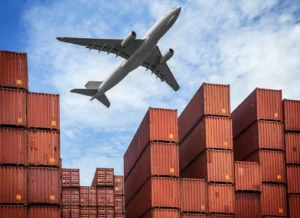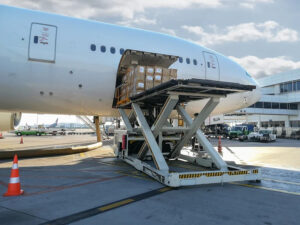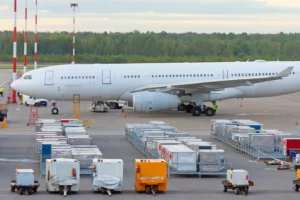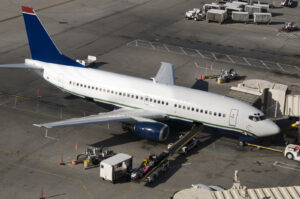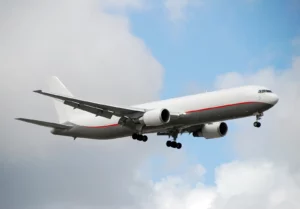
June is another tumultuous month – but little movement in air freight rates
June may have been a tumultuous period in terms of geopolitical developments. But global air freight rates were little changed over the month. In June, the conflict in the Middle East escalated severely – first with Israel mounting massive air strikes on Iran, then Iran responding and finally with the US getting involved as well. During that period of turmoil, there were many delays and cancellations to air traffic in the Middle East. Crude oil prices surged – and jet fuel prices jumped nearly 20% month-on-month to June 20, according to Platts’ data, before falling back sharply after a ceasefire was declared on June 24. Yet the global Baltic Air Freight Index (BAI00) barely moved, drifting a tad lower by -1.1% over the four weeks to June 30 – leaving it down by -5.3% year-on-year. The overall pattern is not surprising perhaps given that some of the busiest lanes in air cargo – such as Transpacific and Transatlantic – do not traverse Middle East airspace, even though there is a lot of air cargo that also moves from Asia to the Americas via Middle East carriers. And the broader outlook for tariffs and trade between the US and China, and between the US and Europe, is of course not driven solely by events in the Middle East. Looking ahead, markets were also focusing on a series of important dates coming up. Notably: During June, rates on the busiest lanes out of Asia were little changed overall. The index of outbound routes from Hong Kong (BAI30) – reflecting the whole spectrum of spot and forward transactions from the biggest airport in the world by cargo volume – was lower but by only -2.7% in the four weeks to June 30, leaving it lower by -10.9% YoY. That said, the new BAI Spot indices – reflecting purely spot market rates reported for Hong Kong to the US East Coast and US West Coast as well as to Europe (which have moved from private to public trials from July 1) – did show significant volatility intra-month. BAI Spot rates were falling steadily in the first half of June, then flattening out mid-month –and then rebounding towards month-end. Meanwhile, overall rates from Shanghai (BAI80) showed a similar pattern to HK, falling by -5.0% MoM to leave that index at -7.6% YoY. Some sources have been suggesting the outlook might be a little more bearish given the withdrawal of some widebody freighters from Transpacific lanes following the US-China trade standoff earlier this year. Others however suggest the market has continued in a pattern of complex interaction between supply and demand we have witnessed all year. Capacity, they suggest – particularly on Transpacific lanes, which are dominated by freighters rather than passenger bellyhold volumes – was continuing to adjust rapidly to the rise and fall of demand. Hence, in periods when demand has been strong, such as in the runup to President Trump’s announcement of higher tariffs on China, capacity has also been high – and then then cut back after the tariffs were announced. More latterly, after the 90-day US-China deal, it seems capacity has been restored to some extent, though not to previous levels – as e-commerce business, at least on China- US lanes, has still been impacted by an end to the de minimis exemption for small parcels. Providing more transparency on those capacity trends is TAC Space, with the beta edition of version 2 now available – providing significantly more detail on multi-leg routes. Meanwhile, rates from Europe remained pretty firm through June, led by Transatlantic lanes – which were still up by close to +20% YoY in late June – but lower YoY on other key lanes such as to China as well as to Japan. The index of outbound routes from Frankfurt (BAI20) edged up +2.6% MoM to remain ahead by +1.3% YoY. From London Heathrow (BAI40) rates continued rebounding strongly from low levels in early May, gaining a further +33.1% MoM to end the month at +31.5% YoY. Out of the US, rate patterns were more mixed – staying lower YoY to China and flattish to Europe but well ahead on lanes to South America, led by strong rates from Miami, which does the lion’s share of that volume. The index of outbound routes from Chicago fell by -0.9% MoM to leave it at +0.4% YoY. Other than the important trade issues, from a global macro perspective markets were also focusing on the sustainability of US debt levels post Trump’s ‘big beautiful bill’ on tax and spending – which pointed towards the federal deficit reaching an alarmingly high 6.2% of GDP in 2025, and adding a projected $2.4 trillion to US debt over 10 years. The bill led ratings agency Moody’s to downgrade the US credit rating by one notch from Aaa to Aa1. The dollar has also continued to fall against other major currencies – dropping from around $1.04 to the euro in early January to around $1.18 by the end of June, and from around $1.20 to the pound sterling to $1.37. Nevertheless, although long-term US bond yields did go up, equity markets have not been unduly affected – at least in the short term – despite considerable debate about the outlook. Those with a more sanguine view were pointing to the fact that US productivity and growth have consistently beaten forecasts throughout the years since Covid. And that higher interest rates also reflect in part expectations of stronger growth going forward. Plus the fact that higher rates arguably reflect a ‘normalisation’ of interest rates – at higher levels than in the ‘abnormal’ era of quantitative easing (QE), which has now finally come to an end. In the era of the new Trump administration, policy decisions and outcomes remain hard to predict. Which means that shippers, freight forwarders and airlines will all be on their toes and watching closely to see not only how events in the Middle East pan out, but also what happens when those dates for decisions on tariffs

